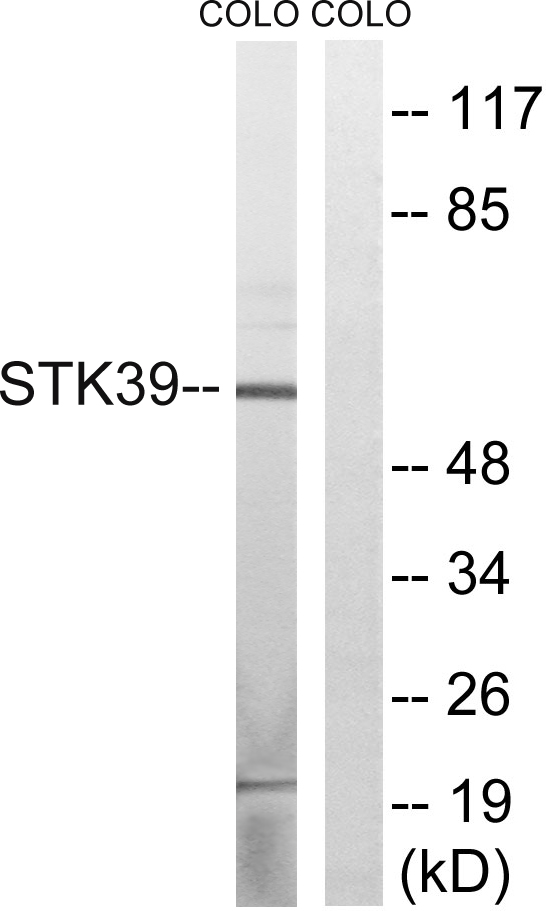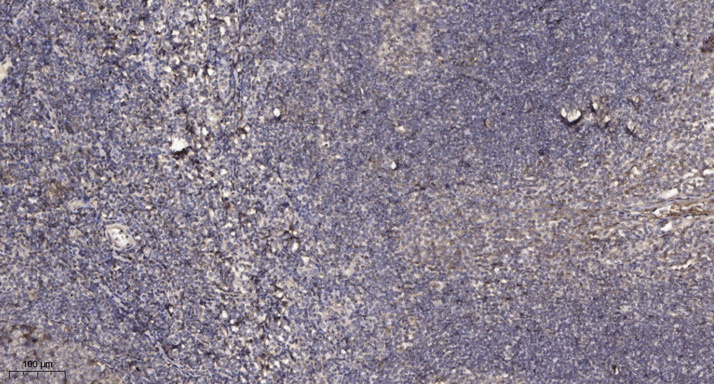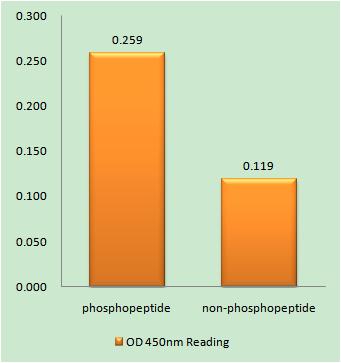SPAK Polyclonal Antibody
- Catalog No.:YT4377
- Applications:WB;IHC;IF;ELISA
- Reactivity:Human;Mouse;Rat
- Target:
- SPAK
- Gene Name:
- STK39
- Protein Name:
- STE20/SPS1-related proline-alanine-rich protein kinase
- Human Gene Id:
- 27347
- Human Swiss Prot No:
- Q9UEW8
- Mouse Gene Id:
- 53416
- Mouse Swiss Prot No:
- Q9Z1W9
- Rat Gene Id:
- 54348
- Rat Swiss Prot No:
- O88506
- Immunogen:
- The antiserum was produced against synthesized peptide derived from human STK39. AA range:277-326
- Specificity:
- SPAK Polyclonal Antibody detects endogenous levels of SPAK protein.
- Formulation:
- Liquid in PBS containing 50% glycerol, 0.5% BSA and 0.02% sodium azide.
- Source:
- Polyclonal, Rabbit,IgG
- Dilution:
- WB 1:500 - 1:2000. IHC 1:100 - 1:300. ELISA: 1:40000.. IF 1:50-200
- Purification:
- The antibody was affinity-purified from rabbit antiserum by affinity-chromatography using epitope-specific immunogen.
- Concentration:
- 1 mg/ml
- Storage Stability:
- -15°C to -25°C/1 year(Do not lower than -25°C)
- Other Name:
- STK39;SPAK;STE20/SPS1-related proline-alanine-rich protein kinase;Ste-20-related kinase;DCHT;Serine/threonine-protein kinase 39
- Observed Band(KD):
- 60kD
- Background:
- This gene encodes a serine/threonine kinase that is thought to function in the cellular stress response pathway. The kinase is activated in response to hypotonic stress, leading to phosphorylation of several cation-chloride-coupled cotransporters. The catalytically active kinase specifically activates the p38 MAP kinase pathway, and its interaction with p38 decreases upon cellular stress, suggesting that this kinase may serve as an intermediate in the response to cellular stress. [provided by RefSeq, Jul 2008],
- Function:
- catalytic activity:ATP + a protein = ADP + a phosphoprotein.,domain:PAPA box (proline-alanine repeats) may target the kinase to a specific subcellular location by facilitating interaction with intracellular proteins such as actin or actin-like proteins.,function:May act as a mediator of stress-activated signals.,similarity:Belongs to the protein kinase superfamily. STE Ser/Thr protein kinase family. STE20 subfamily.,similarity:Contains 1 protein kinase domain.,subcellular location:Nucleus when caspase-cleaved.,tissue specificity:Predominantly expressed in brain and pancreas followed by heart, lung, kidney, skeletal muscle, liver, placenta and testis.,
- Subcellular Location:
- Cytoplasm . Nucleus . Nucleus when caspase-cleaved. .
- Expression:
- Predominantly expressed in brain and pancreas followed by heart, lung, kidney, skeletal muscle, liver, placenta and testis.
- June 19-2018
- WESTERN IMMUNOBLOTTING PROTOCOL
- June 19-2018
- IMMUNOHISTOCHEMISTRY-PARAFFIN PROTOCOL
- June 19-2018
- IMMUNOFLUORESCENCE PROTOCOL
- September 08-2020
- FLOW-CYTOMEYRT-PROTOCOL
- May 20-2022
- Cell-Based ELISA│解您多样本WB检测之困扰
- July 13-2018
- CELL-BASED-ELISA-PROTOCOL-FOR-ACETYL-PROTEIN
- July 13-2018
- CELL-BASED-ELISA-PROTOCOL-FOR-PHOSPHO-PROTEIN
- July 13-2018
- Antibody-FAQs
- Products Images

- Western blot analysis of lysates from COLO cells, using STK39 Antibody. The lane on the right is blocked with the synthesized peptide.

- Western blot analysis of the lysates from HepG2 cells using STK39 antibody.

- Immunohistochemical analysis of paraffin-embedded human tonsil. 1, Antibody was diluted at 1:200(4° overnight). 2, Tris-EDTA,pH9.0 was used for antigen retrieval. 3,Secondary antibody was diluted at 1:200(room temperature, 45min).


